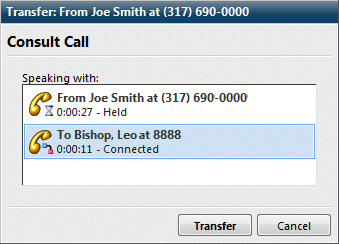|
Interaction Client Web Edition Help |
Transferring an interaction after speaking with the intended recipient is called a consult transfer. If the intended recipient does not answer the phone, you can resume your conversation with the caller, park the call on the intended recipient’s extension, transfer the call to the intended recipient’s voice mail, or try transferring to another person.
Warning: Perform a consult transfer only when you need to speak with both parties before completing the transfer. If this is not necessary, perform a blind transfer. Using a consult transfer to transfer a call to an attendant profile or to an agent's voice mail is not a supported feature. This may result in the original caller being sent to the default attendant profile. For more information about blind transfers, see Transfer a Call Without Consulting the Recipient.
While the call is selected in My Interactions, inform the caller that he or she is going to be transferred.
On the Queue Control toolbar, click the Transfer button.
Result: The Transfer dialog box appears.
In the Transfer To: field, type all or part of the recipient’s name or number.
Result: A drop-down list of choices appears.
Tip: If the drop-down list does not contain the contact you expected, check the search criteria selected in the Options drop-down list and adjust them if necessary.
From the drop-down list, do one of the following:
Select "Dial [your entry] as Digits" to convert a text entry into numbers.
Select the appropriate contact name and associated extension or phone number.
Result: If the intended recipient is a CIC user, status information for the selected CIC user appears. It shows whether the transfer recipient is logged onto Interaction Client and is able to accept the transferred call. This can help you decide what kind of call transfer to use.
Click the Consult button. This enables you to speak with the transfer recipient while your original caller stays on hold.
Result: The Consult Call dialog box appears. Notice that the name of the transfer recipient is selected. If the status of the call is "Connected," you can talk to that party.

Do one of the following:
If the intended recipient answers his or her phone, and agrees to the transfer, click Transfer.
Result: The call is transferred to the intended recipient and disappears from My Interactions.
To speak to the caller without exiting the transfer operation, click the name of the caller.
Note: You might use this feature if the recipient is unavailable to take the interaction and you want to see if the caller would like to be transferred to someone else. If you want to return to speaking to the transfer recipient, click the name of that party.
If the transfer recipient does not answer the phone or does not agree to the transfer, click Cancel.
Result: The Consult Call dialog box closes and the Transfer dialog box reappears. The call is taken off hold, and you are reconnected to it.
Tip: If for some reason you can't perform a consult transfer, you can use the Transfer dialog box to choose another way to handle this call. You can transfer a call to another person’s voicemail, park a call on another person’s extension, or transfer a call without consulting the recipient.
Related Topics